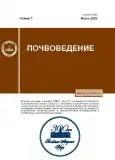Plutonium Accumulation by Vegetation on Different Soils
- Authors: Edomskaya M.A.1, Lukashenko S.N.1, Shupik A.A.1, Shapovalov S.G.1
-
Affiliations:
- Russian Institute of Radiology and Agroecology
- Issue: No 7 (2023)
- Pages: 864-871
- Section: AGRICULTURAL CHEMISTRY AND SOIL FERTILITY
- URL: https://journals.rcsi.science/0032-180X/article/view/138136
- DOI: https://doi.org/10.31857/S0032180X22601463
- EDN: https://elibrary.ru/FQBMUB
- ID: 138136
Cite item
Full Text
Abstract
The high variability of the plutonium transfer factors presented in the literature makes it relevant to study the mechanisms that affect its migration ability and its availability for vegetation. The variability of transfer factors is explained by different properties of soils, since the redox potential and soil acidity can significantly affect the mobility of plutonium. In the vegetation experiment, the migration of plutonium in the “soil-agricultural plant” system was studied for different types of soils. The content of 239 + 240Pu was analyzed by alpha spectrometry with preliminary radiochemical isolation. Plutonium migration parameters were determined using barley (Hordeum) and beans (Fabaceae) as test cultures. The plutonium accumulation coefficients obtained in the course of vegetation experiments are in the range of 3.1 × 10–4–6.8 × 10–3, with an average value of 3.8 × 10–3 for the aboveground part of barley and 9.2 × 10–3–7.6 × 10–2, with an average value of 3.8 × 10–2 – for the root system of barley. The transfer factor range was 1.5 × 10–3–5.7 × 10–3 with an average value of 3.7 × 10–3 and 5.8 × 10–2–6.5 × 10–2 with an average value of 6.2 × 10–2 for the aboveground part and the root system of the beans, respectively. It has been determined that the nature of the plutonium distribution over the vegetative organs of the crops under consideration is non-uniform. On average, the plutonium transfer factor for the aboveground part of plants is lower than for the root part by more than 40 times. It has been determined that the accumulation of plutonium in the aboveground parts of plants growing on different types of soil is not the same for individual species/organs of agricultural plants. For the aboveground part of the agricultural crops under consideration, the transfer factors differ up to several orders of magnitude. In general, the accumulation of plutonium by vegetation growing on different soils types is arranged in the following row: soddy-podzolic (Retisol) and gray forest soil (Phaeozem) > lowland peat-bog (Histosol) \( \gg \) typical chernozem (Chernozem). The smallest accumulation of plutonium by vegetation is observed in soils with a high content of organic matter. For the root system of plants, the dependence of the plutonium accumulation coefficients on the soil type is uncertain.
Keywords
About the authors
M. A. Edomskaya
Russian Institute of Radiology and Agroecology
Author for correspondence.
Email: maisher@mail.ru
Russia, 249032, Obninsk
S. N. Lukashenko
Russian Institute of Radiology and Agroecology
Email: maisher@mail.ru
Russia, 249032, Obninsk
A. A. Shupik
Russian Institute of Radiology and Agroecology
Email: maisher@mail.ru
Russia, 249032, Obninsk
S. G. Shapovalov
Russian Institute of Radiology and Agroecology
Email: maisher@mail.ru
Russia, 249032, Obninsk
References
- Клечковский В.М., Петербургский А.В. Агрохимия: Уч. пос. Колос, 1967. 583 с.
- Лукашенко С.Н. Актуальные вопросы радиоэкологии Казахстана. Павлодар: Дом печати, 2011. Вып. 3. Т 2. 396 с. ISBN: 978-601-7112-38-7
- Лукашенко С.Н., Эдомская М.А. Плутоний в окружающей среде: источники, механизмы распространения, концентрации // Радиационная биология. Радиоэкология. 2021. Т. 61. № 4. С. 394–424. https://doi.org/10.31857/S086980312104007X
- Спиров Р.К., Никитин А.Н., Чешик И.А., Король Р.А. Аккумуляция трансурановых элементов надземными и подземными органами сосудистых растений // Докл. Национальной академии наук Беларуси. 2017. Т. 61. № 2. С. 51–57.
- Тагай С.А. Дударева Н.В., Нилова Е.К. Параметры перехода 241Am, 239 + 240Pu в сельскохозяйственные культуры // Современные проблемы радиобиологии – 2021: Мат-лы междунар. научн. конф. Гомель, 23–24 сентября 2021 г. Минск: Информационно-вычислительный центр Министерства финансов Республики Беларусь, 2021. С. 166–169.
- Шуранкова О.А., Кудряшов В.П. Поступление трансурановых элементов (239 + 240Pu, 241Am) Чернобыльского происхождения в луговую растительность // Проблемы здоровья и экологии. 2006. № 1(7). С. 67–71.
- Balonov M. Handbook of parameter values for the prediction of radionuclide transfer in terrestrial and freshwater environments. Technical Reports Series No. 472. IAEA, 2010.
- Barnett C.L. Quantification of Radionuclide Transfer in Terrestrial and Freshwater Environments for Radiological Assessments. IAEA-TECDOC-1616. IAEA, 2009.
- Beresford N.A., Howard B.J. Handbook of parameter values for the prediction of radionuclide transfer to wildlife. Technical Reports Series No. 479. IAEA, 2014.
- Edomskaya M.A., Lukashenko S.N., Stupakova G.A., Kharkin P.V., Gluchshenko V.N., Korovin S.V. Estimation of radionuclides global fallout levels in the soils of CIS and eastern Europe territory // J. Environ. Radioact. 2022. V. 247. P. 106865. https://doi.org/10.1016/j.jenvrad.2022.106865
- Kozhakhanov T.E., Lukashenko S.N., Larionova N.V. Accumulation of artificial radionuclides in agricultural plants in the area used for surface nuclear tests // J. Environ. Radioact. 2014. V. 137. P. 217–226. https://doi.org/10.1016/j.jenvrad.2014.06.026
- Larionova N.V., Lukashenko S.N., Kabdyrakova A.M., Kunduzbayeva A.Y., Panitskiy A.V., Ivanova A.R. Transfer of radionuclides to plants of natural ecosystems at the Semipalatinsk Test Site // J. Environ. Radioact. 2018. V. 186. P. 63–70. https://doi.org/10.1016/j.jenvrad.2017.09.006
- Lux D., Kammerer L., Rühm W., Wirth E. Cycling of Pu, Sr, Cs, and other longliving radionuclides in forest ecosystems of the 30-km zone around Chernobyl // Sci. Total Environ. 1995. V. 173. P. 375–384. https://doi.org/10.1016/0048-9697(95)04741-7
- Sokolik G.A., Ovsiannikova S.V., Ivanova T.G., Leinova S.L. Soil–plant transfer of plutonium and americium in contaminated regions of Belarus after the Chernobyl catastrophe // Environ. Int. 2004. V. 30. P. 939–947. https://doi.org/10.1016/j.envint.2004.03.003
Supplementary files











